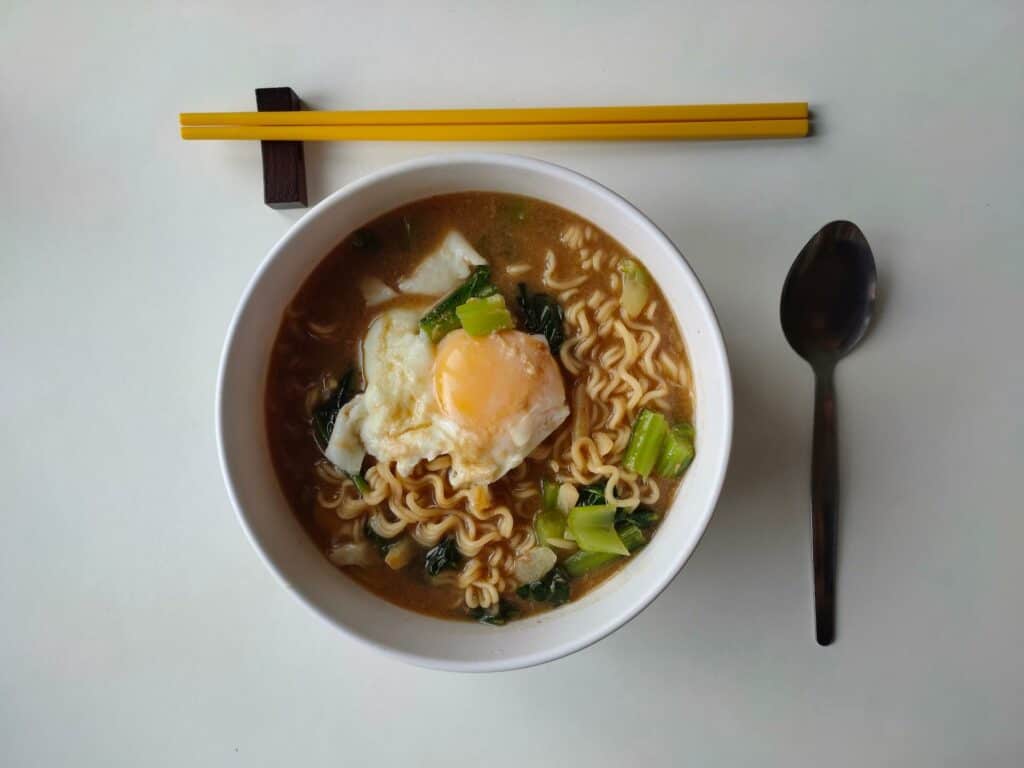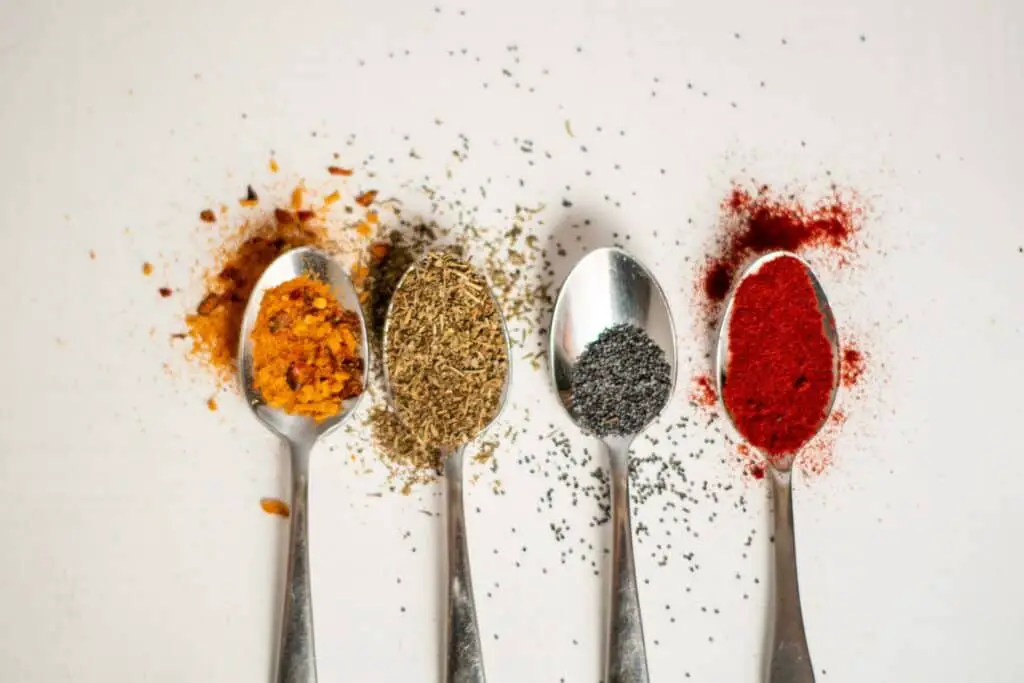If you want to add more flavor to your ramen soup than you would get with the instant mix, you’ll have to learn a thing or two on how to make ramen seasoning. Don’t worry – it’s as simple as it gets.
To make ramen seasoning, you should simply mix the spices with bullion cubes (meat or vegan). Blend salt, cumin, ginger, black pepper, parsley, garlic, and onion powder with bullion, and add the mixture to already prepared noodles. You can also add thyme leaves, turmeric, coriander seeds, or traditional condiments, like shoyu sauce and miso paste, for more exotic tastes.


In the following text, I’ll provide you with some of the best tips about ramen seasoning (and more), so make sure you keep reading.
How to Make Ramen Seasoning? Ingredients You’ll Need for This Homemade Ramen Recipe
Making ramen seasoning couldn’t be simpler – all you have to do is mix all the ingredients together, and voila – spices are prepared.
Let’s just start by saying there are countless ramen seasoning blend recipes – and I have tried many of them to get to the best one. Therefore, instead of going through the trial and error process as I did, all you have to do is gather the following ingredients:
- Ground black pepper – ½ tsp,
- Ground ginger – ½ tsp,
- Ground cumin – ½ tsp,
- Onion powder – 1 tsp,
- Garlic powder – 2 tsp,
- Bullion (chicken, beef, or vegetable) – 3 cubes,
- Dried parsley – 1 tsp,
- Salt – ½ tsp,
- Cayenne – ½ tsp (if you want to make ramen less spicy, just ignore this ingredient).
Which Spices Are Typically Used in Other Ramen Seasoning Recipes?
Although I find the previously mentioned blend excellent, note that there are many other ingredients people use for homemade seasoning – some more exotic than others. If you want to add more flavor, consider mixing an additional spice, like:
- Pepper flakes,
- Thyme leaves,
- Coriander seed,
- White pepper,
- Turmeric,
- Star anise,
- Cinamon.
Why Shouldn’t You Use Premade Seasoning?
If you’re on this page, you probably already know there is a difference between the premade seasoning mix you get with instant ramen packs and a homemade recipe with fresh spices. So, let’s summarize – a premade mix is not that good for your general health.
It has high monosodium glutamate (flavor enhancer) and sodium content, which are known to trigger many diseases. Therefore, making your own spice blend is a much better choice – and it won’t even take much of your time.

What Kind of Noodles Should You Use?
Aside from seasoning, noodles are another main part of this dish. But must you use real ramen or instant one? Instant noodles are an excellent solution when you need a fast meal, but note that freshly made noodles are a much healthier alternative.
Most instant noodle producers deep-fry their products, which makes them high in unsaturated fat. But that is not all – they are also high in sodium and low in beneficial nutrients, like protein and fiber.
Fresh noodles are not only healthier, but with them, you’ll also have various choices. Different ramen shops will offer you chew or thin, straight or wavy, firm or soft noodles. Fresh noodles are the way to go if you want to prepare a high-quality meal.
Are There Any Recipes With Alternative Types of Noodles?
Even though fresh noodles are healthier, they are also full of carbohydrates since they are made from kansui mineral water, egg, and wheat flour. However, many other types of noodles can be suitable, keto-friendly ramen alternatives. Take a look at the table below to see some examples:
| Shirataki | Zucchini | Kelp |
| Low in carbohydrates | Low in carbohydrates | Low in carbohydrates |
| Low in calories | Low in calories | Low in calories |
| Rich in fiber | Gluten-free | Fat-free |
| Similar texture to traditional noodles | Easy to prepare | Sugar-free |
| Free from most common allergens | High in vitamins | High in vitamins |
| High in potassium | High in minerals (iron, zinc, calcium, and magnesium) | |
| High in antioxidants | No preparation time needed |
How to Make Ramen?
Once you’ve prepared the seasoning, you still need to combine the spices with the noodles to get ramen. Here is what you should do:
- Step 1 – Boil two cups of water,
- Step 2 – Add noodles and let them cook for approximately three minutes,
- Step 3 – Remove the pot with noodles from the heat,
- Step 4 – Add the blend and stir.
If you want to add more flavors to the meal, I suggest you add chopped scallions when you pour the ramen into the bowl (about ⅓ cup), as well as some sesame seeds (a teaspoon).
Remember that this blend also works well with ramen recipes that include meat and vegetables. Moreover, you can use it as an excellent mix for many other meals, aside from ramen noodles.
Traditional Types of Ramen
Although it originated from China, ramen has been one of the favorite dishes all over Japan for many years. Japanese cuisine recognizes several ramen types – and their distinction is usually based on the seasoning used. Thus there are:
- Shoyu – the most popular type of ramen, seasoned with shoyu (soy sauce). It has a darker brown color. It’s often blended with chicken broth.
- Shio – shio is a Japanese word used for salt, and it’s the saltiest type of ramen. It’s clearer than shoyu ramen and can be mixed with chicken broth but also seafood and pork.
- Miso – this ramen is seasoned with fermented soybean paste of the same name. If you’re looking for a traditional umami flavor, you’ll find it by adding miso to the meal. Fun fact – did you know it’s the type of ramen Naruto eats?
- Tonkotsu – a type of ramen made from simmered pork bones which give the dish an amazingly silky texture.
Easy to Prepare but Still Delicious, Homemade Ramen Is a Favorite Dish for Many Home Chefs
Whether you want to choose an instant or fresh ramen, a keto-friendly or regular one, the spices added will make or break the meal. Although a premade mix can have a satisfying taste, it can’t ever be as healthy and deep in flavor as a freshly made blend. Luckily, all you have to do is gather the ingredients and mix them – and the seasoning is prepared.